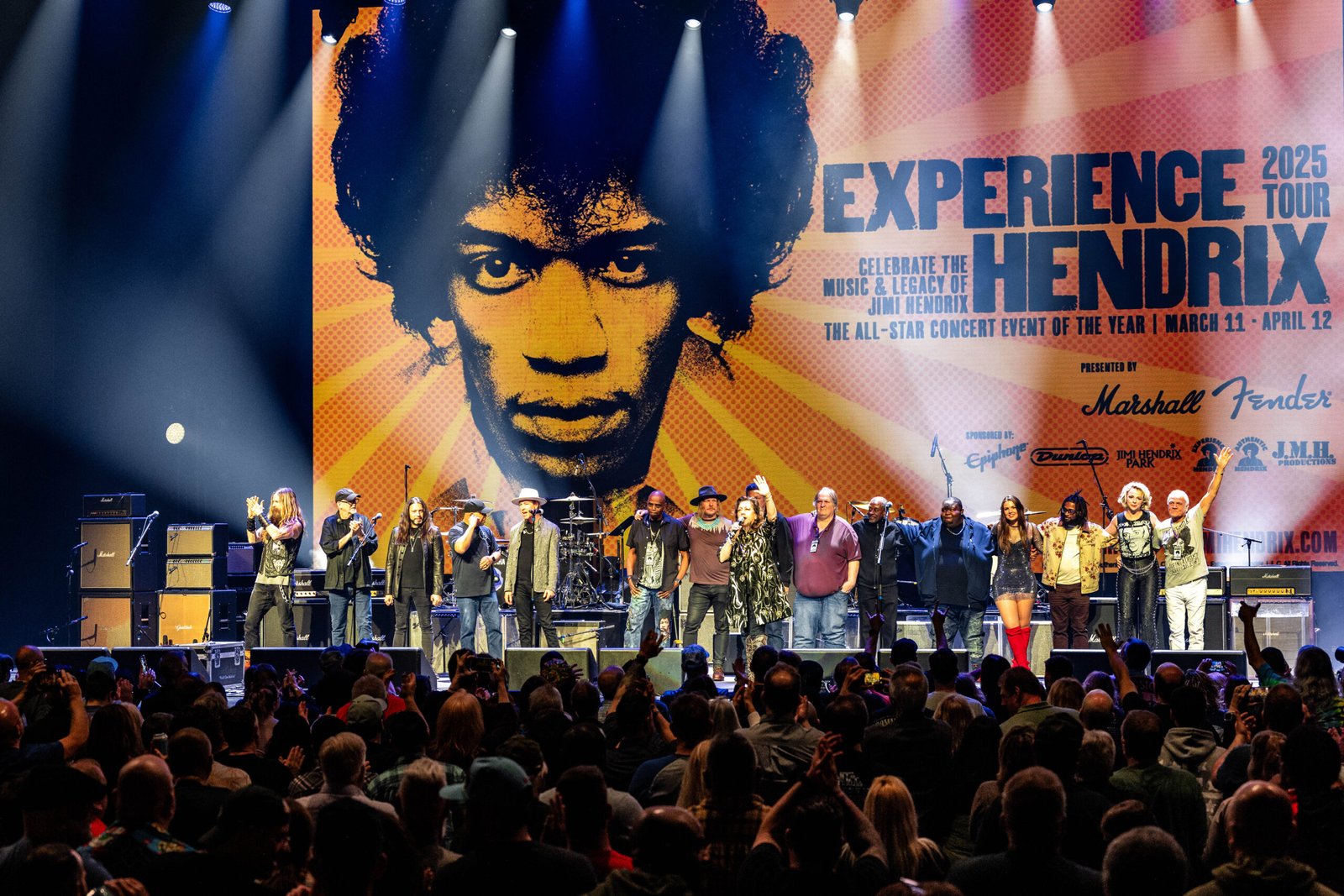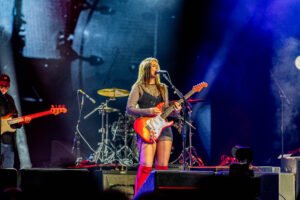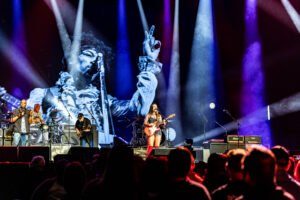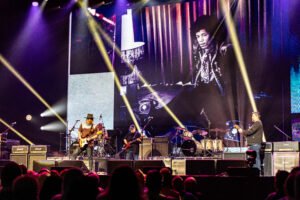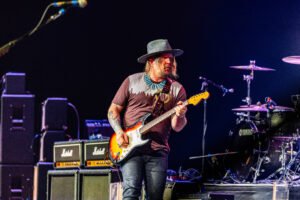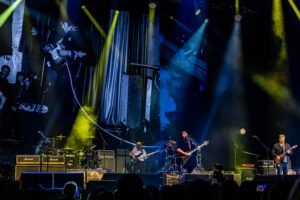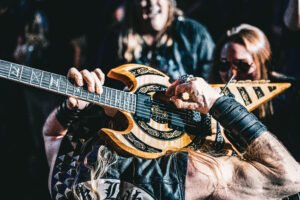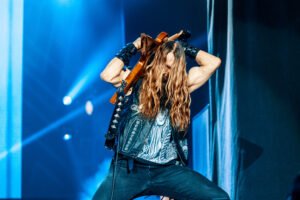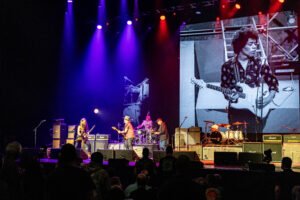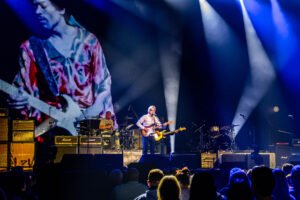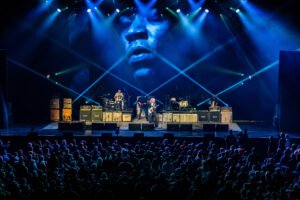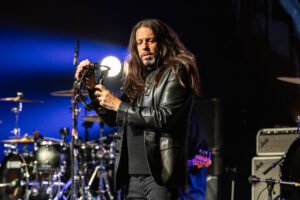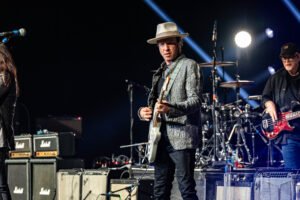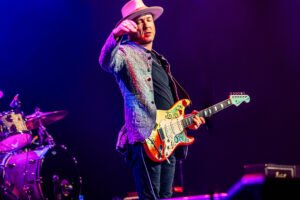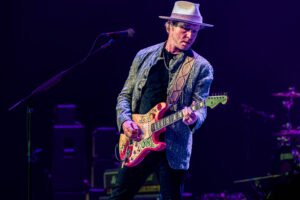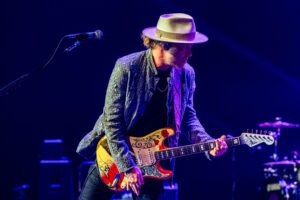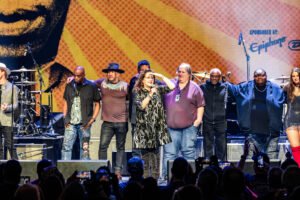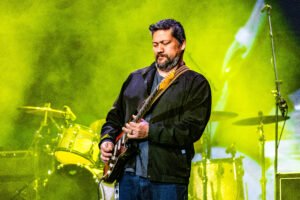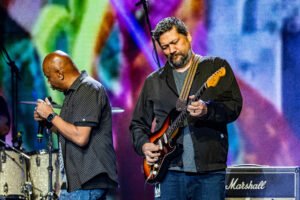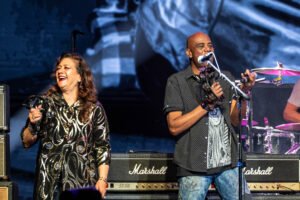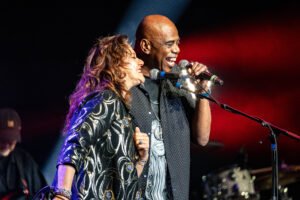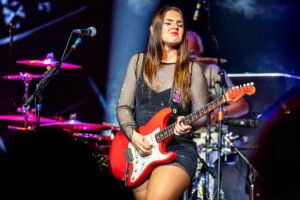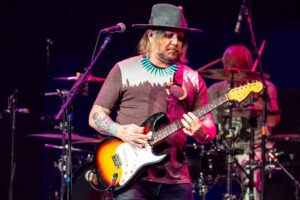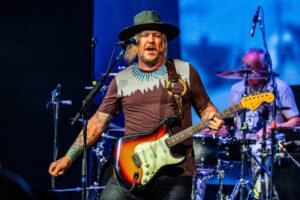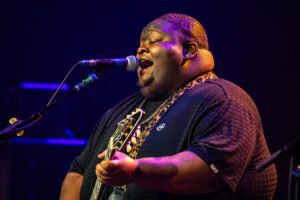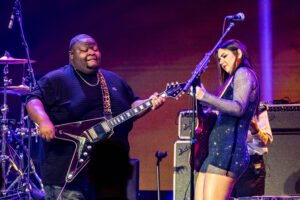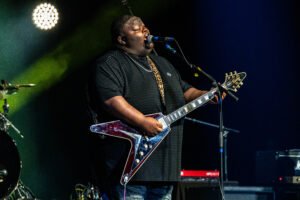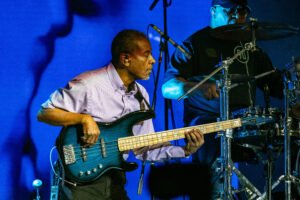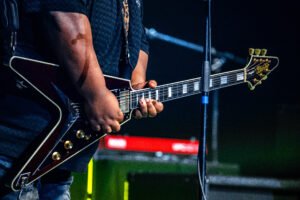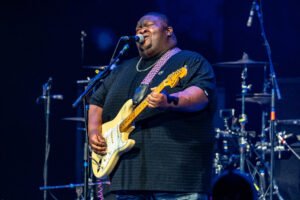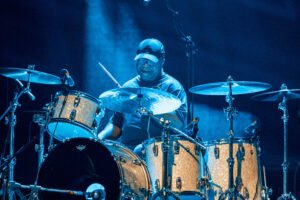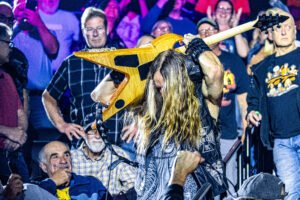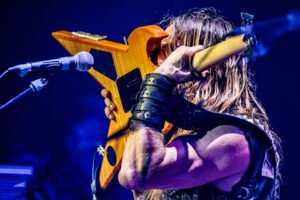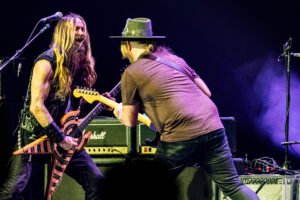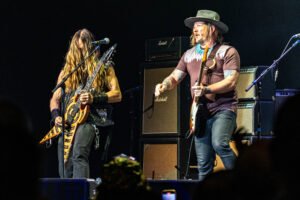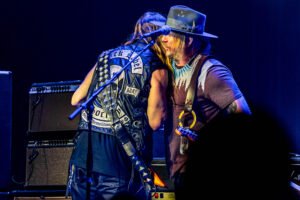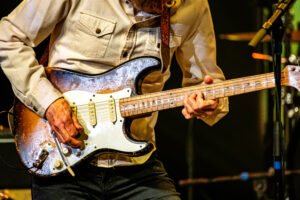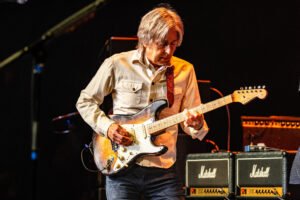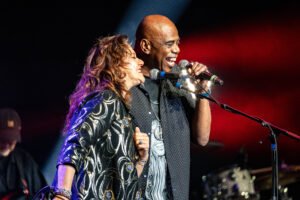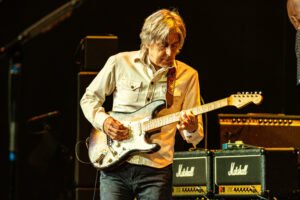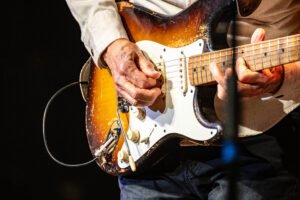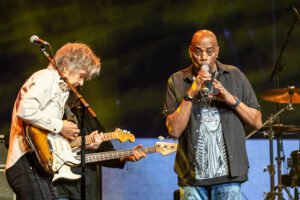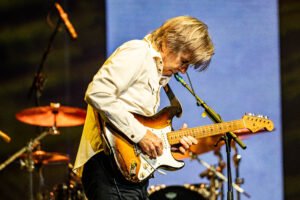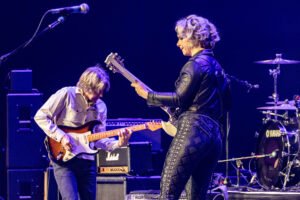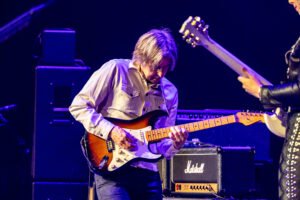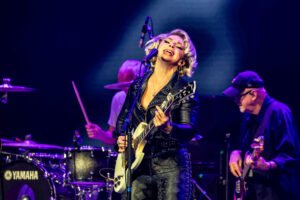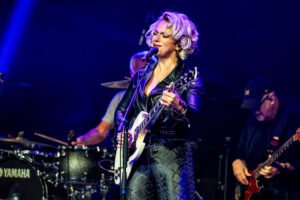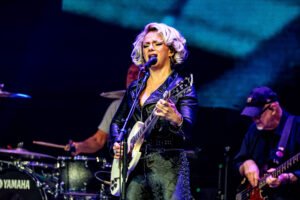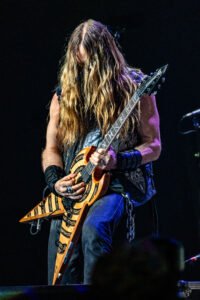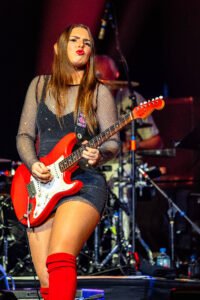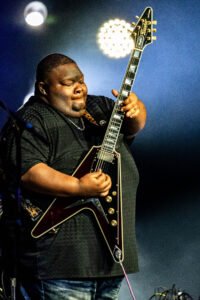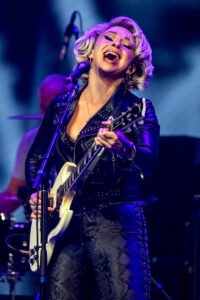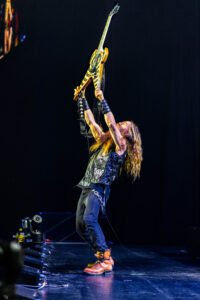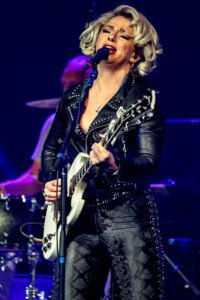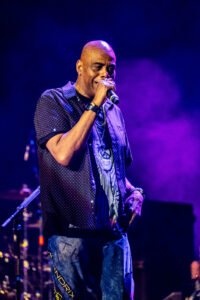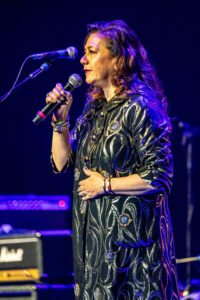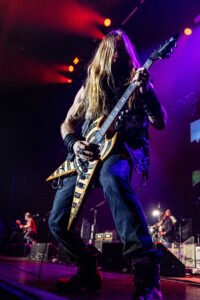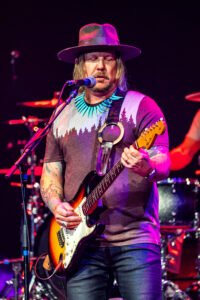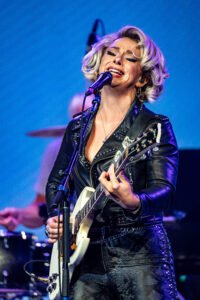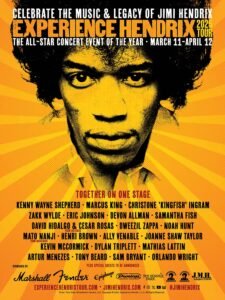
Jimi Hendrix’s career, though tragically brief, left an indelible mark on the history of music. Rising to prominence in the mid-1960s, Hendrix formed the Jimi Hendrix Experience with bassist Noel Redding and drummer Mitch Mitchell, releasing the groundbreaking debut album Are You Experienced in 1967. His fusion of blues, rock, soul, and psychedelia pushed the boundaries of what electric guitar could do. With iconic performances at the Monterey Pop Festival, where he famously set his guitar on fire, and Woodstock, where he delivered a haunting rendition of “The Star-Spangled Banner,” Hendrix established himself as a singular force in live performance. Albums like Axis: Bold as Love and Electric Ladyland showcased his masterful songwriting, innovative use of studio effects, and unprecedented guitar techniques, including feedback, wah-wah pedals, and reverse tape.
Hendrix’s influence on music and guitar playing is immeasurable. He redefined the role of the electric guitar, inspiring countless artists across genres—from blues and rock to funk and heavy metal. His ability to channel raw emotion through his instrument laid the groundwork for expressive guitar soloing, and his stylistic innovations helped shape the sound of modern rock. Beyond technical prowess, Hendrix’s bold experimentation with song structure and production changed how musicians approached the recording process. Even decades after his death in 1970, his music remains a benchmark for artistic creativity, and he is regularly cited as one of the greatest guitarists of all time. His legacy lives on through generations of players who continue to study, emulate, and build upon his visionary approach.
The Experience Hendrix Tour began in 1995 under the original name The Jimi Hendrix Electric Guitar Festival, born from a desire to celebrate the groundbreaking music and enduring legacy of Jimi Hendrix. Spearheaded by the Hendrix family, particularly his devoted step-sister Janie Hendrix, the event quickly evolved into a full-fledged national tour, uniting guitarists from all walks of music in honor of Jimi’s unparalleled artistry. The tour not only offered fans the opportunity to experience Hendrix’s music live, but it also served as a powerful tribute, highlighting the immense respect he commanded across generations. As the tour gained momentum, it was rebranded as the Experience Hendrix Tour, becoming a staple event that has continued for decades, playing packed theaters and arenas across North America with a rotating lineup of world-class musicians.
Over the years, the Experience Hendrix Tour has attracted an all-star cast of guitar legends and rising stars alike, all paying homage to Jimi’s genius. Eric Johnson, Joe Satriani, Zakk Wylde, Jonny Lang, Kenny Wayne Shepherd, Dweezil Zappa, Billy Cox (Hendrix’s original Band of Gypsys bassist), Mato Nanji, Doyle Bramhall II, and many others have lent their talents to reimagine classics like “Voodoo Child,” “Purple Haze,” and “Little Wing” onstage. This ongoing project would not be possible without the tireless dedication of Janie Hendrix, who has spent decades managing Jimi’s estate, curating posthumous releases, and organizing events that keep his music alive for new audiences. Through her stewardship, Hendrix’s legacy has not only endured—it has grown, reaching younger generations and preserving the spirit of one of music’s most transformative figures. And tonight’s extraordinary live tribute at Ovation Hall in Atlantic City, NJ would no doubt leave a lasting impact on every soul in attendance.
The Experience Hendrix show at Ovation Hall in Atlantic City opened with a reverent and heartfelt moment as Janie Hendrix took the stage beneath a glowing purple spotlight. The audience rose to their feet in admiration as she offered a warm welcome and spoke passionately about her step-brother’s enduring legacy. With genuine emotion in her voice, Janie recounted the origins of the tour—originally launched in 1995 as The Jimi Hendrix Electric Guitar Festival—and its evolution into the Experience Hendrix Tour, a now-legendary traveling celebration of Jimi’s music. She thanked the audience for keeping Jimi’s spirit alive and emphasized how much it meant to see his songs continue to inspire people across the globe. Her speech struck a powerful chord, seamlessly connecting Jimi’s revolutionary impact with the contemporary musicians assembled for the night.
As the lights shifted to a fiery red, singer and emcee Henri Brown burst onto the stage with infectious energy, kicking off the musical portion of the evening with a thunderous version of “Foxy Lady.” Brown, Jimi Hendrix’s cousin and a longtime fixture of the tour, was joined by the powerhouse trio of Mato Nanji on guitar, Orlando Wright on bass, and Sam Bryant on drums. Nanji’s searing guitar licks channeled the essence of Jimi’s tone, blending fuzz, feedback, and controlled chaos into every riff. Wright and Bryant locked in with heavy, confident grooves, giving the performance both muscle and finesse. Without missing a beat, the group launched into “Fire,” with Brown swaggering across the stage and igniting the crowd with his soulful delivery and charismatic presence. The combination of deep familial reverence and raw musical talent set the tone for an unforgettable night, proving that Jimi’s fire still burns brightly on stages around the world.
Ally Venable took the stage with confident swagger, her Stratocaster slung low and a glimmer of mischief in her eyes as she prepared to channel the spirit of Hendrix through her own fiery brand of blues-rock. Launching into a blistering version of “Fire,” she wasted no time asserting her command of the fretboard, delivering explosive riffs and scorching solos that brought the crowd to its feet. Her tone crackled with raw energy, perfectly matching the intensity of the iconic track. Adding to the excitement, Jani Hendrix and Henri Brown joined her onstage—Jani keeping time on tambourine while providing subtle yet soulful background vocals alongside Brown, whose rich harmonies and lively stage presence elevated the performance. The chemistry between the trio radiated joy and reverence, giving “Fire” a celebratory vibe that was both fresh and deeply rooted in legacy. Venable’s dynamic stage presence and fearless playing style made it clear that she wasn’t just covering Hendrix—she was embodying his spirit.
As the lights softened to a moody blue and red wash, Ally eased into the opening notes of “Red House,” shifting the energy from explosive to introspective. With soulful bends and expressive phrasing, she poured emotion into every note, evoking the heartbreak and longing that lie at the core of Hendrix’s blues masterpiece. Her vocal delivery was raw and intimate, drawing listeners into the story while her guitar wept, moaned, and soared. The performance had the feel of a late-night blues club session—personal and vulnerable—yet delivered with the commanding presence of a seasoned headliner. As the solo built to a climax, the crowd responded with thunderous applause, recognizing the depth of emotion and technical brilliance on display. It was a stunning showcase of Ally Venable’s artistry, honoring Hendrix’s legacy not by imitation, but by breathing new life into his songs with authenticity, power, and soul.
Devon Allman stepped into the spotlight with a quiet intensity, cradling his guitar as the first delicate notes of “Little Wing” drifted through the venue. Backed by a tasteful rhythm section, Allman approached the Hendrix ballad with deep reverence, his phrasing slow and intentional, allowing each note to linger in the air. His tone was buttery smooth yet tinged with a soulful grit, evoking both the vulnerability and strength embedded in the song. With subtle vibrato and expressive bends, Allman painted a sonic portrait that honored Jimi’s ethereal masterpiece while infusing it with Southern blues flavor and a personal emotional depth. His vocals were soft and plaintive, floating gently over the instrumentation, and as he reached the instrumental climax, he let the guitar do the storytelling—melodic, fluid, and soaring. The performance cast a spell over the audience, who responded with hushed awe and heartfelt applause as the final notes faded.
With little warning, Allman shifted gears and dove headfirst into a muscular rendition of “Are You Experienced,” immediately flooding the hall with swirling fuzz tones and a churning psychedelic groove. His guitar roared to life, thick with sustain and attitude, as he led the band through the song’s hypnotic rhythm and mystical lyricism. The performance was bold and experimental, echoing Hendrix’s original spirit of fearless sonic exploration. Devon twisted knobs and manipulated his effects with finesse, creating waves of feedback and shimmering echoes that turned the stage into a vortex of sound. His vocals were commanding, almost cryptic, drawing the audience deeper into the surreal atmosphere of the song. It was a daring and transformative moment—Allman not only captured the song’s complexity but elevated it, channeling his own musical heritage into Hendrix’s vision and reminding the crowd that innovation and soul are at the very heart of this legacy.
When Zakk Wylde stormed the stage at Ovation Hall, the energy in the room instantly surged as he Just as the crowd thought they had seen it all, Wylde leapt off the stage and into the audience, still soloing with relentless fire. Fans parted as he made his way down the aisle, shredding face-melting runs inches away from screaming concertgoers. The moment blurred the line between stage and floor, turning the entire venue into his personal arena. His presence was magnetic and larger-than-life, a physical embodiment of Hendrix’s explosive and unpredictable spirit. Upn his return to the stage, Zall unleashed the thunderous opening riff to “Manic Depression.” Dressed in his signature kilt and wielding his iconic bullseye Les Paul, Wylde brought a feral intensity to the Experience Hendrix stage, his playing equal parts brute force and blistering technique. As the rhythm section thundered beneath him, he tore into the song’s swirling, off-kilter groove with jaw-dropping speed and precision, his fingers a blur across the fretboard.
Without letting up, Wylde returned later in the set for a jaw-droppingly emotional rendition of “Little Wing,” once again descending into the crowd as he launched into the song’s iconic instrumental passages. His interpretation traded some of the song’s fragility for raw, cathartic passion—his solos soaring above the audience, filled with dramatic swells, squealing harmonics, and mournful bends. The crowd was transfixed, phones held high and jaws dropped as Zakk poured soul and fury into each note, standing shoulder-to-shoulder with fans, channeling Hendrix through sheer power and presence. Then, with the stage lights pulsing deep purple and the unmistakable riff of “Purple Haze” ripping into the night, Devon Allman rejoined Zakk for a volcanic finale. The two guitarists traded licks, harmonized leads, and built a wall of sound that seemed to shake the foundation of the hall. Wylde’s thick, chugging rhythm meshed perfectly with Allman’s fluid, bluesy runs, and together they created a celebration of Hendrix’s most iconic anthem that was equal parts chaos and control, reverence and rebellion. It was a musical firestorm—two titans igniting the crowd in a tribute that was nothing short of transcendent.
Christone “Kingfish” Ingram’s set began with a haunting, slow-burning take on “Hey Joe” that immediately showcased the depth of his artistry and command of the blues. Standing center stage, Kingfish let his Stratocaster weep and wail with aching bends and rich sustain, each note soaked in emotion. His vocals were equally gripping—smooth, sorrowful, and filled with the weight of the story being told. As the song built in intensity, he unleashed a solo that was both restrained and ferocious, demonstrating his uncanny ability to blend classic blues phrasing with a modern fire that few can match. The audience, captivated and silent during the verses, erupted into cheers as Kingfish took the song to a thunderous climax, his guitar howling with righteous fury. It was a performance that felt timeless—deeply rooted in Hendrix’s spirit but unmistakably stamped with Kingfish’s own identity.
From there, Kingfish shifted into a raucous rendition of “Killing Floor,” and was soon joined by fellow blues shredder Ally Venable, who emerged from the wings grinning and ready to trade licks. The chemistry between the two was electric—Kingfish laying down thick, biting riffs while Ally answered with razor-sharp leads of her own, the two guitarists pushing each other higher with every pass. Their dueling solos turned the classic into a vibrant, exhilarating jam, full of playful swagger and mutual respect. After Ally exited to roaring applause, Kingfish closed his set with a thunderous version of “Catfish Blues,” locking into a swampy groove that paid tribute to Hendrix’s deep blues roots. Stretching the song into a slow, hypnotic burner, he allowed space for call-and-response interplay between his vocals and guitar, each phrase dripping with soul. With every note, Kingfish reminded the crowd that Hendrix’s blues foundation still breathes, still growls—and through players like him, it continues to evolve with heart, grit, and unmistakable authenticity.
Eric Johnson’s segment unfolded like a masterclass in tone, precision, and reverence, beginning with a powerhouse rendition of “Power of Love.” With his signature crystalline Stratocaster tone cutting cleanly through the mix, Johnson crafted each note like a painter with a fine brush. Henri Brown took center stage on vocals, his voice brimming with funk and command, delivering the lyrics with raw conviction and soulful swagger. Johnson’s fluid solos danced around Brown’s vocals with surgical finesse—never overpowering, always elevating. The two locked in beautifully, with Johnson’s intricate phrasing and rhythmic flourishes transforming the song into a vibrant, groove-heavy opener that set the bar high for what was to follow.
Johnson then welcomed rising blues and soul vocalist Dylan Triplett to the stage, lending his smooth, expressive voice to “One Rainy Wish.” The pairing was a revelation—Triplett’s vocals soared with gentle vulnerability while Johnson’s guitar offered shimmering arpeggios and atmospheric bends that wrapped around the melody like a dream. The performance felt intimate and otherworldly, drenched in emotional weight and sonic nuance. Without pause, the duo transitioned into a richly textured version of “Burning of the Midnight Lamp.” Johnson layered the opening with cascading effects and delay, recreating the psychedelic aura of the original with otherworldly grace. Triplett delivered the vocals with a sense of aching melancholy, his tone haunted and warm, as Johnson wove subtle melodic filigree beneath him. The combination of Dylan’s vintage soul and Eric’s ethereal touch gave the song a sense of timelessness, evoking both the past and present in perfect harmony.
For “Angel,” the stage shifted again as Samantha Fish joined Johnson with her slide guitar in hand, her voice delicate yet resolute. The two guitarists exchanged tender phrases, never rushing, letting the melody bloom organically. Fish took lead vocals, pouring her heart into the lyrics with quiet intensity, while Johnson echoed her sentiment with heartfelt leads and silken harmonies. Their interplay was graceful and restrained, filled with space and sensitivity, capturing the emotional core of one of Hendrix’s most tender compositions. Closing out his set, Johnson returned to the forefront for a fiery rendition of “Spanish Castle Magic.” The mood flipped instantly—he attacked the riffs with bright, stinging articulation, his fingers flying across the fretboard with effortless precision. His solo was a cascade of cascading runs, harmonics, and whammy bar flourishes, all executed with his trademark elegance. The crowd responded with thunderous applause, fully aware they had just witnessed a guitarist at the peak of his interpretive power, translating Hendrix’s adventurous spirit through his own singular voice.
Samantha Fish brought a fierce, genre-bending energy to the Experience Hendrix stage as she launched into a sultry, psychedelic take on “If 6 Was 9.” Dressed in black leather and wielding her custom cigar box guitar with gritty elegance, she channeled Jimi’s defiant attitude with a performance that was as much statement as it was song. Her vocals were smoky and rebellious, delivering each line with a cool swagger that felt both hypnotic and razor-sharp. Fish manipulated her effects pedals with precision, bathing the track in warped tones, fuzz-drenched slides, and eerie feedback, recreating the tune’s strange beauty with a modern, blues-rock edge. The middle section opened into a spacey, experimental jam where she unleashed a torrent of bends, harmonics, and wild sonic textures that left the crowd in awe. Every movement, every note felt like a deliberate embrace of Hendrix’s boundary-pushing ethos—and the audience hung on every word and phrase.
After a brief breath, Fish returned to fire up “Crosstown Traffic” with a burst of funk-infused electricity. Switching to her main guitar, she locked in with the rhythm section and delivered the song’s driving riff with gritty conviction and relentless energy. Her voice took on a punchier, playful tone, perfectly matching the urgency and sass of the lyrics. The performance was tight and explosive—gritty guitar lines tangled with sharp rhythmic breaks as she danced across the fretboard with equal parts grace and aggression. Fish tore into a stinging solo mid-song, injecting blues licks and wah-drenched chaos into the classic structure, yet never veering too far from its infectious groove. It was a thrilling ride from start to finish—an exhilarating mix of funk, rock, and blues that captured the song’s spirit while showcasing Samantha Fish’s fearless artistry. In these two tracks, she not only paid homage to Jimi’s rebellious heart but affirmed her place among the most dynamic interpreters of his legacy.
Kenny Wayne Shepherd’s entrance marked one of the most electrifying moments of the Experience Hendrix tour, with the Louisiana-born guitar slinger stepping onto the stage with his signature blue Fender Strat and a calm confidence that immediately commanded attention. He launched into “Gypsy Eyes” with a dirty, swinging groove, locking into the track’s hypnotic rhythm with his rhythm section while Noah Hunt took the mic and delivered the vocals with soulful grit and swagger. Shepherd’s tone was sharp, greasy, and punchy—his leads darting between verses with tasteful phrasing and fearless improvisation. He leaned into the song’s blues-rock pulse, injecting his own Southern flair without ever straying too far from Hendrix’s original vibe. As he built the solo toward a roaring crescendo, the room erupted in cheers, the audience swept up in the seamless marriage of technical skill and emotional fire.
Without missing a beat, the band slid into the raucous blues standard “Come On (Let the Good Times Roll),” bringing a surge of raw energy that had the entire crowd clapping along. Hunt’s vocals were warm and infectious, capturing the spirit of Hendrix’s version with a looseness and joy that felt utterly genuine. Shepherd’s playing here was less about flash and more about feel—his licks snappy, rhythmically tight, and overflowing with swing. Trading solos with the keyboardist and slipping in double-stops and blistering turnarounds, he turned the song into a celebration of blues tradition, injecting a barn-burning energy that kept the audience grinning and moving. The chemistry between Shepherd and Hunt was undeniable, years of collaboration showing through in their unspoken cues and mutual energy. It felt like a jam between old friends—just with a few thousand fans invited along for the ride.
Then came the thunder—the unmistakable rumble of “Voodoo Chile.” With the stage bathed in moody red and violet lights, Shepherd dug into the slow, swampy groove with reverence and restraint, letting the opening notes breathe. Noah Hunt’s vocals turned solemn and commanding, perfectly embodying the mythic quality of the song’s bluesy storytelling. Shepherd unleashed slow-burning leads soaked in wah and vibrato, making his Strat cry, howl, and moan like a living thing. As the solo stretched out, he moved from eerie ambience to explosive flourishes, working the fretboard with eyes closed and total immersion. It was less a performance and more a ritual—Shepherd tapping into the ghost of Hendrix and summoning it through sheer sonic force. Every note told a story, every phrase felt hand-carved, and the audience stood transfixed as time seemed to dissolve under the weight of the music.
For the grand finale, “Voodoo Child (Slight Return),” Shepherd hit the gas and lit the crowd on fire. The wah-drenched opening riff burst from his amp like a lightning strike, and from there, it was a full-speed celebration of Hendrix’s most iconic anthem. Noah Hunt matched the intensity, belting the lyrics with a gritty growl as Shepherd tore through the verses with controlled fury. The solo section was jaw-dropping—Shepherd weaving together classic Hendrix phrasing with his own unmistakable touch, pushing the dynamics higher and higher until it felt like the roof might come off the place. The interplay between him and the rhythm section was razor-sharp, every hit and turn executed with surgical timing yet brimming with raw spontaneity. As he hit the final, thunderous chord, the crowd rose in a deafening ovation, knowing they had just witnessed not just a tribute, but a resurrection—Kenny Wayne Shepherd and Noah Hunt channeling the spirit of Hendrix through mastery, soul, and boundless passion.
As the final notes of “Voodoo Child (Slight Return)” rang out across Ovation Hall, the crowd stood in stunned silence for a moment before erupting into a thunderous, heartfelt ovation—a roar of appreciation that echoed Hendrix’s own revolutionary spirit. The energy in the room was electric, the air thick with the shared feeling that something profound had taken place. From the first fuzz-soaked note to the final screaming solo, the Experience Hendrix show had been a spiritual journey—equal parts tribute, celebration, and revival. Fans young and old were united by the power of Hendrix’s music, many of them witnessing it interpreted live for the first time, not through recordings, but through the hands and voices of those carrying his flame forward. The performances weren’t carbon copies—they were living, breathing expressions that honored Jimi’s essence while allowing each artist to leave their own fingerprints on the legacy.
This night in Atlantic City was more than just a concert—it was proof that Jimi Hendrix’s music continues to evolve, inspire, and ignite hearts more than five decades after his passing. Through the vision and dedication of Jani Hendrix and the incredible lineup of world-class musicians, the Experience Hendrix tour has become a traveling monument to Jimi’s brilliance, reaching new generations while reminding longtime fans of the timelessness of his work. Each note played and every lyric sung served as a powerful reminder that Hendrix’s influence knows no boundaries—musical, cultural, or generational. As the house lights came up and the crowd filtered out, smiles wide and ears ringing, one thing was undeniable: the torch is still burning, and Jimi Hendrix’s music is very much alive.

